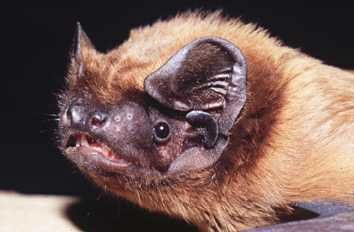The "large nectol" bat Nyctalus lasiopterus is the largest insectivorous among the European bats, with a wingspan of 45 cm. Recently he switched his diet to small birds
 Every spring and every autumn about 5 billion songbirds cross the Mediterranean Sea, from Africa to Europe and back.
Every spring and every autumn about 5 billion songbirds cross the Mediterranean Sea, from Africa to Europe and back.
Most songbirds cross the sea at night, the flight over the sea at night is easier due to weak winds and also safer due to less exposure to raptors. But it turns out that there are those who know how to use the conditions of the night for their "earnings" and the fact that the songbirds fly in the dark to their advantage.
In Europe, West Asia and North Africa there is a bat whose way of life is unknown, the "big nectole" bat Nyctalus lasiopterus is the largest insectivore among the European bats, with a wingspan of 45 cm, contrary to the accepted norm, the bat is also the largest of all European fruit eaters, probably grown allowing it to do something previously unknown to bat researchers.
The "Nectol" spends the cold winter months in (partial) dormancy. In the spring, the nectul wakes up hungry, at the same time millions of songbirds cross the sea. The noctole utilizes its ability to locate objects with the help of ultrasonic localization and prey on songbirds in flight. In this way it is probably the only bat (and the only mammal) that preys on songbirds while flying. Bats (and other mammals) are known to catch birds... but only those that are at rest, on tree branches or on the ground.
Insectivorous bats, as their name suggests, eat insects in the air while flying. The suspicion that Henkelt was a predator of birds arose when researchers found feathers in sites where the bats sleep. To verify their suspicion, the researchers examined the secretions of the bats throughout the year. From the examination, it turned out that in the fall and spring, periods when the birds migrate, the secretions of the bats contain large amounts of remains of feathers and bones originating from... birds .
An isotope test of carbon and nitrogen in the blood of bats strengthens the findings, the researchers came to the conclusion that: in the summer the bat eats insects, in the spring the menu is mixed and in the fall it relies on birds that provide 70% of its food. The migration of the birds is a diverse and rich source of food that Hankelt learned to exploit.
The study was conducted by: Ana Popa-Lisseanu of the Consejo Superior de Investigaciones Cientificas in Seville, Spain, and published in: Public Library of Science journal PLoS ONE.
Over millions of years, bats have adapted to a variety of habitats and types of food: insects, small vertebrates, pollen, fruits and even blood. According to the researcher, "Predating songbirds (at night) while flying is a uniqueness that is not known among other carnivores/raptors."
Dr. Assaf Rosenthal,
Tour guide/leader in Africa and South America.
For details: Tel. 0505640309 / 077-6172298,
Email: assaf@eilatcity.co.il

2 תגובות
From the evolutionary point of view - does this mean that this nectole will eventually learn to sing as well?